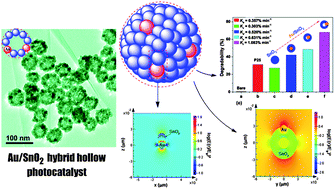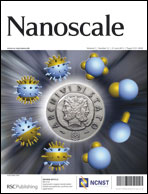We present an innovative approach to the production of sub-100 nm hollow Au–SnO2 hybrid nanospheres, employing a low-cost, surfactant-free and environmentally friendly solution-based route. The hollow hybrid nanostructures were synthesized using a seed-mediated hydrothermal method, which can be divided into two stages: (1) formation of multicore–shell Au@SnO2 nanoparticles (NPs) and (2) thermal diffusion and ripening to form hollow Au–SnO2 hybrid NPs. The morphology, optical properties and formation mechanism were determined by a collection of joint techniques. Photocatalytic degradation of Rhodamine B (RhB) in the liquid phase served as a probe reaction to evaluate the activity of the as-prepared hollow hybrid Au–SnO2 NPs under the irradiation of both visible light and ultraviolet light. Significantly, the as-obtained Au–SnO2 hybrid nanostructures exhibited enhanced visible light or UV photocatalytic abilities, remarkably superior to commercial pure SnO2 products and P25 TiO2, mainly owing to the effective electron hole separation at the SnO2–Au interfaces and strong localization of plasmonic near-fields effects.

You have access to this article
 Please wait while we load your content...
Something went wrong. Try again?
Please wait while we load your content...
Something went wrong. Try again?


 Please wait while we load your content...
Please wait while we load your content...